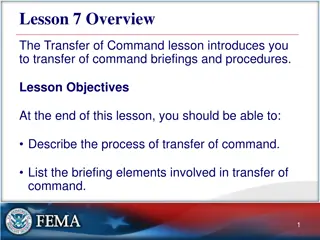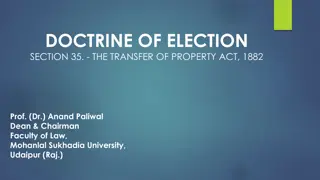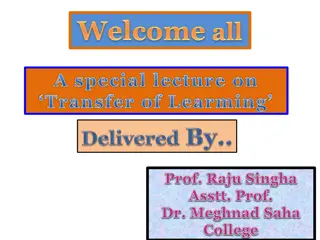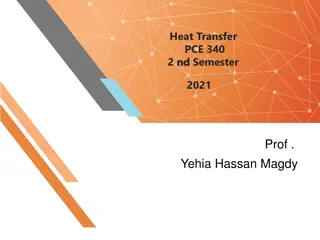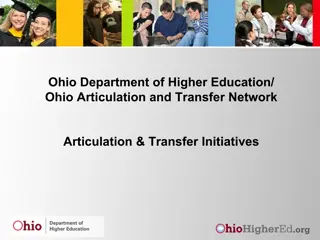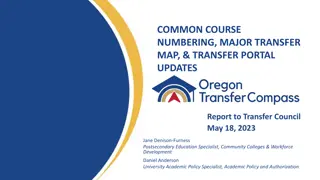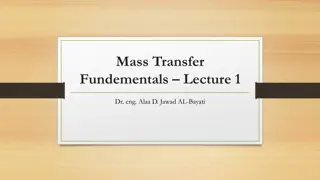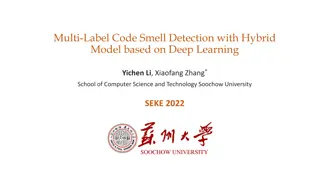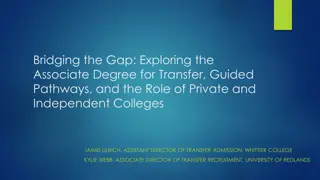Understanding Deep Transfer Learning and Multi-task Learning
Deep Transfer Learning and Multi-task Learning involve transferring knowledge from a source domain to a target domain, benefiting tasks such as image classification, sentiment analysis, and time series prediction. Taxonomies of Transfer Learning categorize approaches like model fine-tuning, multi-task learning, and self-taught clustering. Additionally, model fine-tuning allows for the adaptation of pre-trained models from labeled source data to new tasks with limited labeled target data, avoiding overfitting.
Download Presentation

Please find below an Image/Link to download the presentation.
The content on the website is provided AS IS for your information and personal use only. It may not be sold, licensed, or shared on other websites without obtaining consent from the author. Download presentation by click this link. If you encounter any issues during the download, it is possible that the publisher has removed the file from their server.
E N D
Presentation Transcript
Deep Transfer Learning and Multi-task Learning
Transfer Learning Transfer a model trained on source data A to target data B Task transfer: in this case, the source and target data can be the same Image classification -> image segmentation Machine translation -> sentiment analysis Time series prediction -> time series classification Data transfer: Images of everyday objects -> medical images Chinese -> English Physiological signals of one patient -> another patient Rationale: similar feature can be useful in different tasks, or shared by different yet related data.
Taxonomy of Transfer Learning Target Data Labeled Unlabeled Model fine-tuning Multi-task learning Domain-adversarial training Zero-shot learning Self-taught learning Labeled Source Data Self-taught clustering Unlabeled Hongyi Li, Transfer Learning. https://speech.ee.ntu.edu.tw/~tlkagk/courses/ML_2016/Lecture/transfer%20(v3).pdf.
Taxonomy of Transfer Learning Target Data Labeled Unlabeled Model fine-tuning Multi-task learning Domain-adversarial training Zero-shot learning Self-taught learning Labeled Source Data Self-taught clustering Unlabeled Hongyi Li, Transfer Learning. https://speech.ee.ntu.edu.tw/~tlkagk/courses/ML_2016/Lecture/transfer%20(v3).pdf.
Taxonomy of Transfer Learning Target Data Labeled Unlabeled Model fine-tuning Multi-task learning Domain-adversarial training Zero-shot learning Self-taught learning Labeled Source Data Self-taught clustering Unlabeled Hongyi Li, Transfer Learning. https://speech.ee.ntu.edu.tw/~tlkagk/courses/ML_2016/Lecture/transfer%20(v3).pdf.
Model Fine Tuning For a model trained on a large amount of labeled source data, transfer it to target data with very little labeled target data. E.g. Application Source Data Target Data Medical image segmentation Segmentations of many images of daily scenes Segmentations of several medical images Speech recognition Audio data and transcriptions of many historical speaker Limited audio data and transcriptions of a new speaker Arrhythmia detection Very-long ECG signals of a large number of historical patients ECG snippet from a new patient Idea: Pre-train a model using labeled source data, then fine-tune the model with labeled target data. Caution: Do NOT overfit the limited amount of labeled target data! Hongyi Li, Transfer Learning. https://speech.ee.ntu.edu.tw/~tlkagk/courses/ML_2016/Lecture/transfer%20(v3).pdf.
Conservative Training Output Layer Output Layer Hidden Layers Hidden Layers Use parameters of pre-trained model to initialize the parameters of the new model; Further train the new model on target data. Limit the number of epochs to avoid over-fitting! Input Layer Input Layer Source Data Target Data Hongyi Li, Transfer Learning. https://speech.ee.ntu.edu.tw/~tlkagk/courses/ML_2016/Lecture/transfer%20(v3).pdf.
Layer Transfer Output Layer Output Layer Hidden Layer 3 Hidden Layer 3 Use parameters of pre-trained model to initialize the parameters of the new model; Freeze the parameters of some hidden layers; parameters of other layers on target data. Limit the number of epochs to avoid over-fitting! Usually, freeze the first or last few layers. Hidden Layer 2 Hidden Layer 2 (Freeze!) Hidden Layer 1 Hidden Layer 1 (Freeze!) only fine-tune Input Layer Input Layer Source Data Target Data Hongyi Li, Transfer Learning. https://speech.ee.ntu.edu.tw/~tlkagk/courses/ML_2016/Lecture/transfer%20(v3).pdf.
Open-source Pre-trained Models Using open-source pre-trained models for transfer learning is an effective and efficient way to acquire high-quality deep learning results for your applications! Pre-trained Models for Natural Language Processing (NLP) BERT GPT-3 Pre-trained Models for Computer Vision (CV) VGG-16 ResNet50 ViT
BERT: Bidirectional Encoder Representations from Transformers A natural language processing model proposed by Google in 2018; pre-trained on 2,500 million words of Wikipedia and 800 million words of Book Corpus; allows for training customized question answering models in a few hours in using a single GPU; available at https://github.com/google-research/bert. Variants: CodeBERT, RoBERTa, ALBERT, XLNet,
GPT-3: Generative Pre-trained Transformer 3 A natural language processing model proposed by OpenAI in 2020; trained on 175 billion parameters, which is 10 times more than any previous non-sparse language model available; strong at tasks such as translation, answering questions, as well as on- the-fly reasoning-based tasks like unscrambling words has been applied to writing news, generating codes available at https://openai.com/api/.
VGG-16 A computer vision model proposed by the Visual Geometry Group from Oxford; pre-trained on the ImageNet corpus; first runner-up of ILSVRC (ImageNet Large Scale Visual Recognition Competition) 2014 in the classification task a CNN model with 16 layers and about 138 million parameters; has been built into popular deep learning frameworks such as PyTorch and Keras. Variant: VGG-19
ResNet50 A variant of the ResNet model, a computer vision model proposed by Microsoft in 2015; pre-trained on the ImageNet corpus; a CNN model with 50 layers and about 380 million parameters; has been built into popular deep learning frameworks such as PyTorch and Keras.
ViT: Vision Transformer A computer vision (CV) model proposed by Google in 2020; introduces the Transformer architecture, which has achieved huge success in natural language processing, into CV; the idea is treating patches in images as words in text; can achieve better accuracy and efficiency than CNNs such as ResNet50; available at https://github.com/google-research/vision_transformer. Variants: Swin Transformer, PVTv2
Taxonomy of Transfer Learning Target Data Labeled Unlabeled Model fine-tuning Multi-task learning Domain-adversarial training Zero-shot learning Self-taught learning Labeled Source Data Self-taught clustering Unlabeled Hongyi Li, Transfer Learning. https://speech.ee.ntu.edu.tw/~tlkagk/courses/ML_2016/Lecture/transfer%20(v3).pdf.
Multi-task Learning (MTL) Simultaneously undertaking multiple tasks using a single network. E.g. Simultaneous ECG heartbeat segmentation and classification Simultaneous neutrino energy prediction and direction prediction We don not necessarily need multiple main tasks. Rather, we can have one main task and several auxiliary tasks to support the main task. (Story for another time!) Domain adaptation Self-supervision . Basic forms of MTL: hard or soft parameter sharing.
Hard Parameter Sharing Different tasks share some layers (i.e. the parameters of these layers), usually used for feature extraction for input data. The output of the shared layers (usually learned features) is fed to different task-specific layers to obtain the final results. Output Layer (Task A) Output Layer (Task B) Task-specific layers Task-specific layers (Task A) (Task A) Task-specific layers (Task B) Shared Layers (Feature Extractor) Input Layer (Tasks A & B) Input Layer (Tasks A & B) Sebastian Ruder, An Overview of Multi-Task Learning in Deep Neural Networks. https://ruder.io/multi-task/.
Soft Parameter Sharing Replace shared layers (with identical parameters) with constrained layers, which have similar or related parameters. The similarity or relatedness of parameters than can be controlled by a regularization term in the loss function, or through connections between constrained layers of different tasks. Output Layer (Task B) Output Layer (Task A) Unconstrained layers (Task A) Unconstrained layers (Task B) Constrained Layers (Task A) Constrained Layers (Task B) Input Layer (Task A) Input Layer (Task B) Sebastian Ruder, An Overview of Multi-Task Learning in Deep Neural Networks. https://ruder.io/multi-task/.
Why does MTL work? Implicit data augmentation: If different tasks have different input data, then each task can benefit from the extra knowledge encoded in the input of other tasks. Even if all tasks share the same data, simultaneously learning for multiple tasks can reduce the risk of overfitting for each one of these tasks. Enhanced feature learning It may be the case that a specific task is so noisy that we cannot learn the most relevant features if we only deal with that particular task. Including other tasks makes it easier to uncover truly relevant features. Besides, some features are easier to learn for some tasks than others. Handling all tasks together can help enhance the latter s performance. Sebastian Ruder, An Overview of Multi-Task Learning in Deep Neural Networks. https://ruder.io/multi-task/.
MTL-Example: Image Segmentation and Depth Regression Fusing semantic segmentation, instance segmentation and per-pixel depth regression tasks using hard parameter sharing. Kendall, Alex, Yarin Gal, and Roberto Cipolla. "Multi-task learning using uncertainty to weigh losses for scene geometry and semantics." Proceedings of the IEEE conference on computer vision and pattern recognition. 2018.
MTL-Example: High-definition Radar Fusing vehicle detection and free-space segmentation tasks by hard parameter sharing. Rebut, Julien, et al. "Raw High-Definition Radar for Multi-Task Learning." Proceedings of the IEEE/CVF Conference on Computer Vision and Pattern Recognition. 2022.
MTL Example: Cross Language Knowledge Transfer Fusing language-specific tasks using multi-lingual feature transformation layers by hard parameter sharing. Huang, Jui-Ting, et al. "Cross-language knowledge transfer using multilingual deep neural network with shared hidden layers." 2013 IEEE International Conference on Acoustics, Speech and Signal Processing. IEEE, 2013.
MTL Example: Text Classification Hard parameter sharing: one shared LSTM Hard & soft parameter sharing: two constrained LSTMs connected by one shared bi-LSTM Liu, Pengfei, Xipeng Qiu, and Xuanjing Huang. "Recurrent neural network for text classification with multi-task learning." arXiv preprint arXiv:1605.05101 (2016). Soft parameter sharing: two constrained LSTMs with connections
MTL Example: Correlated Time Series Forecasting Fusing task-specific layers using shared layers by hard parameter sharing. Cirstea, Razvan-Gabriel, et al. "Correlated time series forecasting using multi-task deep neural networks." Proceedings of the 27th acm international conference on information and knowledge management. 2018.
References 1. Hongyi Li, Transfer Learning. https://speech.ee.ntu.edu.tw/~tlkagk/courses/ML_2016/Lecture/transfer%20(v3).pdf. 2. Sejuti Das. Top 8 Pre-Trained NLP Models Developers Must Know. https://analyticsindiamag.com/top-8-pre-trained-nlp-models- developers-must-know/. 3. Devlin, Jacob, et al. "Bert: Pre-training of deep bidirectional transformers for language understanding." arXiv preprint arXiv:1810.04805 (2018). 4. Brown, Tom, etFeng, Zhangyin, et al. "Codebert: A pre-trained model for programming and natural languages." arXiv preprint arXiv:2002.08155 (2020). al. "Language models are few-shot learners." Advances in neural information processing systems 33 (2020): 1877-1901. 5. Liu, Yinhan, et al. "Roberta: A robustly optimized bert pretraining approach." arXiv preprint arXiv:1907.11692 (2019). 6. Lan, Zhenzhong, et al. "Albert: A lite bert for self-supervised learning of language representations." arXiv preprint arXiv:1909.11942 (2019). 7. Yang, Zhilin, et al. "Xlnet: Generalized autoregressive pretraining for language understanding." Advances in neural information processing systems 32 (2019). 8. Simonyan, Karen, and Andrew Zisserman. "Very deep convolutional networks for large-scale image recognition." arXiv preprint arXiv:1409.1556 (2014). 9. He, Kaiming, et al. "Deep residual learning for image recognition." Proceedings of the IEEE conference on computer vision and pattern recognition. 2016. 10. Dosovitskiy, Alexey, et al. "An image is worth 16x16 words: Transformers for image recognition at scale." arXiv preprint arXiv:2010.11929 (2020). 11. Liu, Ze, et al. "Swin transformer: Hierarchical vision transformer using shifted windows." Proceedings of the IEEE/CVF International Conference on Computer Vision. 2021. 12. Wang, Wenhai, et al. "Pvt v2: Improved baselines with pyramid vision transformer." Computational Visual Media 8.3 (2022): 415-424.
References 13. Sebastian Ruder, An Overview of Multi-Task Learning in Deep Neural Networks. https://ruder.io/multi-task/. 14. Kendall, Alex, Yarin Gal, and Roberto Cipolla. "Multi-task learning using uncertainty to weigh losses for scene geometry and semantics." Proceedings of the IEEE conference on computer vision and pattern recognition. 2018. 15. Rebut, Julien, et al. "Raw High-Definition Radar for Multi-Task Learning." Proceedings of the IEEE/CVF Conference on Computer Vision and Pattern Recognition. 2022. 16. Huang, Jui-Ting, et al. "Cross-language knowledge transfer using multilingual deep neural network with shared hidden layers." 2013 IEEE International Conference on Acoustics, Speech and Signal Processing. IEEE, 2013. 17. Liu, Pengfei, Xipeng Qiu, and Xuanjing Huang. "Recurrent neural network for text classification with multi-task learning." arXiv preprint arXiv:1605.05101 (2016). 18. Cirstea, Razvan-Gabriel, et al. "Correlated time series forecasting using multi-task deep neural networks." Proceedings of the 27th acm international conference on information and knowledge management. 2018.






